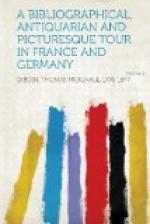[S] as dede thyng they were peynte.
[T] in.
[U] to fare.
[V] as deest.
[W] as cartes led awey.
[X] Vnto.
[Y] In MS. Harl. 753, a break is here made, and a
large capital letter
introduced.
[Z] to deest.
[AA] sithe.
[AB] vp he.
[AC] atte porte kauxoz.
[AD] atte porte.
[AE] that stounde.
[AF] Crosses.
[AG] xliiij.
[AH] religiouns.
[AI] atte porte hauxoz.
[AJ] The remainder, of this, and the two following lines are omitted.
[AK] Thanked.
[AL] they seyde our lord so free.
[AM] vnto.
[AN] the deest.
[AO] to.
[AP] As.
[AQ] Poitrell, breast plate.
[AR] hangyng.
[AS] dide deest.
[AT] the chere.
[AU] The chaplains of his household. Lat. capella.
[AV] atte dore, there deest.
[AW] afore.
[AX] respon.
[AY] logged hym.
[AZ] his cite fast encrest.
[BA] beste.
[BB] that deest.
[BC] tydyng.
[BD] his deest.
[BE] on.
[BF] seyde all for charitee.
BRONZE GILT ANTIQUE STATUE AT LILLEBONNE, p. 127-8.
This Statue, as the above reference will testify, is now in the possession of Mr. Samuel Woodburn, of St. Martin’s Lane. When the note relating to it was written, I could, not place my hand upon a Brochure (in my possession) published at Rouen in 1823,[176] containing an archaeological description of this Statue by M. Revet, and a scientific account of its component parts, by M. Houton La Billardiere, Professor of Chemistry at Rouen. The former embodied his remarks in two letters addressed to the Prefect of the Lower Seine. A print of the figure in its then extremely mutilated state, is prefixed; but its omission would have been no great drawback to the publication—which, in its details, appears to be ingenious, learned, and satisfactory. The highest praise is given to the Statue, as a work of art of the second century.[177] Its identity seems to be yet a subject of disputation:—but M. Revet considers it as “the representation of some idolatrous divinity.” The opinion of its being a representation of Bacchus, or of Apollo, or of a Constellation, he thinks might be regulated by a discovery of some emblem, or attribute, found in the vicinity of the Statue. Two other plates—lithographised—relating to explanations of the pieces of the Statue, close this interesting performance.
[176] “Description de la, Statue Fruste,
en Bronze Dore, trouvee a
Lillebonne &c. Suivie
de l’Analyse du Metal, avec le dessein de la
Statue, et les Traces de quelques
particularites relatives a la
Confection de cette Antique.”
Rouen, 1823. pp. 56.




